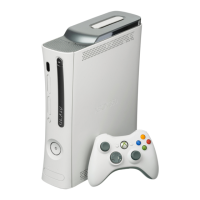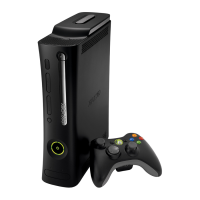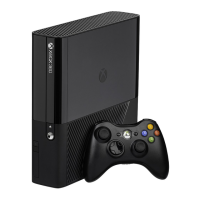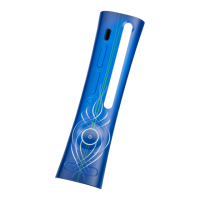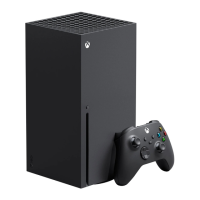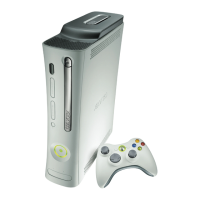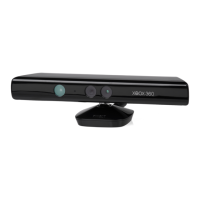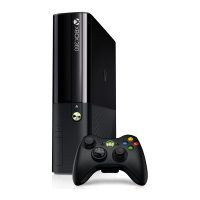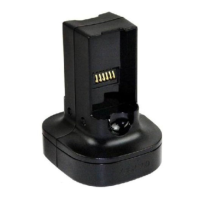Before playing:
• Look in all directions (right, left, forward, backward, down, and
up) for things you might hit or trip over.
• Make sure your play space is far enough away from windows,
walls, stairs, etc.
• Make sure there is nothing you might trip on—toys, furniture,
or loose rugs, for example. Also, be aware of children and pets
in the area. If necessary, move objects or people out of the play
space.
• Don’t forget to look up. Be aware of light xtures, fans, and other
objects overhead when assessing the play space.
While playing:
• Stay far enough away from the television (TV) to avoid contact.
• Keep enough distance from other players, bystanders, and pets.
This distance may vary between games, so take account of how
you are playing when determining how far away you need to be.
• Stay alert for objects or people you might hit or trip on. People
and objects can move into the area during gameplay, so always
be alert to your surroundings.
Make sure you always have good footing while playing:
• Play on a level oor with enough traction for game activities.
• Make sure you have appropriate footwear for gaming (no high
heels, ip ops, etc.) or are barefoot, if appropriate.
Use of these accessories or objects may result in injury to yourself or
others and/or in damage to the sensor or other property.
As with many other electrical devices, failure to take the
following precautions can result in serious injury or death from
electric shock or re or damage to the Xbox 360 console.
Select an appropriate power source for your Xbox 360 console:
• Use only the power supply unit and AC power cord that came
with your console or that you received from an authorised
repair centre. If you are not sure if you have the correct power
supply unit, compare the model number on the power supply
unit with the model number specied on your console. If you
need a replacement power supply unit or AC power cord, you
can nd Xbox Customer Support contact information at
• Conrm that your electrical outlet provides the type of power
indicated on the power supply unit (in terms of voltage [V]
and frequency [Hz]). If you are not sure of the type of power
supplied to your home, consult a qualied electrician.
• Do not use non-standard power sources, such as generators or
inverters, even if the voltage and frequency appear acceptable.
Use only AC power provided by a standard wall outlet.
• Do not overload your wall outlet, extension cord, power strip,
or other electrical receptacle. Conrm that they are rated to
handle the total current (in amps [A]) drawn by the Xbox 360
console (indicated on the power supply unit) and any other
devices that are on the same circuit.
• Do not connect any other devices between the power supply
unit and the Xbox 360 console or between the power cord and
the power supply unit.
To avoid damaging the power cords and power supply:
• Protect the power cords from being walked on.
• Protect cords from being pinched or sharply bent, particularly
where they connect to the power outlet, the power supply unit,
and the console.
• Do not jerk, knot, sharply bend, or otherwise abuse the power
cords.
• Do not expose the power cords to sources of heat.
• Do not wrap power cords around the power supply unit.
• Keep children and pets away from the power cords. Do not
allow them to bite or chew on them.
• When disconnecting the power cords, pull on the plug—do
not pull on the cord.
• Do not let the power supply unit hang from either power cord.
If a power cord or power supply unit becomes damaged
in any way, stop using it immediately. Visit
for Xbox Customer Support
contact information.
Unplug your Xbox 360 console during lightning storms or when
unused for long periods of time.
Always connect the power cord according to the following instructions:
Plug the AC power cord into the power supply until it stops.
Plug the other end of the AC power cord into the wall outlet.
Improper use of batteries may result in battery uid leakage,
overheating, or explosion. There is a risk of explosion if batteries are
replaced by an incorrect type. Use and replace only with correct size
and type of batteries. Released battery uid is corrosive and may be
toxic. It can cause skin and eye burns, and is harmful if swallowed.
To reduce the risk of injury:
• Keep batteries out of reach of children.
• Do not heat, open, puncture, mutilate, or dispose of batteries
in re.
• Use only alkaline (not rechargeable) batteries for best
performance.
• Do not mix new and old batteries or batteries of different types.
• Do not allow metal objects to touch the battery terminals on the
device; they can become hot and cause burns.
• Remove the batteries if they are worn out or before storing your
controller for an extended period of time.
• If a battery leaks, remove all batteries, taking care to keep the
leaked uid from touching your skin or clothes. If uid from the
battery comes into contact with skin or clothes, ush skin with
water immediately. Before inserting new batteries, thoroughly
clean the battery compartment with a damp paper towel, or
follow the battery manufacturer’s recommendations for cleanup.
• Dispose of batteries in accordance with local and national
disposal regulations (if any).
To avoid pinching ngers when inserting, push only on the at
surface of the battery compartment cover.
Before boarding any aircraft or packing the wireless controller
in luggage that will be checked, remove any batteries from the
wireless controller. The wireless controller can transmit radio
frequency (RF) energy, much like a cellular telephone, whenever
batteries are installed.
A very small percentage of people may experience a seizure
when exposed to certain visual images, including ashing
lights or patterns that may appear in video games. Even people
who have no history of seizures or epilepsy may have an
undiagnosed condition that can cause these “photosensitive
epileptic seizures” while watching video games.
These seizures may have a variety of symptoms, including
lightheadedness, altered vision, eye or face twitching, jerking
or shaking of arms or legs, disorientation, confusion, or
momentary loss of awareness. Seizures may also cause loss of
consciousness or convulsions that can lead to injury from falling
down or striking nearby objects.
Immediately stop playing and consult a doctor if you
experience any of these symptoms. Parents should watch for
or ask their children about the above symptoms—children
and teenagers are more likely than adults to experience these
seizures. The risk of photosensitive epileptic seizures may be
reduced by taking the following precautions:
• Sit or stand farther from the TV screen.
• Use a smaller TV screen.
• Play in a well-lit room.
• Do not play when you are drowsy or fatigued.
If you or any of your relatives have a history of seizures or
epilepsy, consult a doctor before playing.
x188018903MNL.indd 2 3/13/13 5:42 PM
